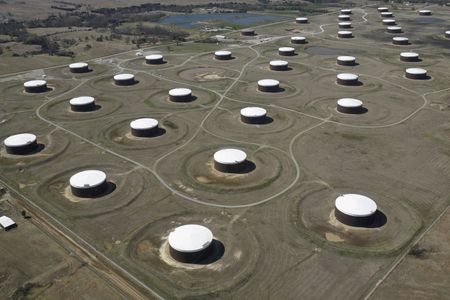
By Julia Payne
LONDON (Reuters) -Oil prices continued to slide on Wednesday on investor worries about the ailing state of the global economy, the prospect of central bank interest rate hikes, and increased restrictions to curb COVID-19 in China.
Brent crude futures for October, due to expire on Wednesday, were down $3.56 at $95.75 a barrel following Tuesday’s $5.78 loss. The more active November contract was down $2.70, or 2.76%, at $95.14 a barrel.
U.S. West Texas Intermediate (WTI) crude futures were down $2.58, or 2.82%, at $89.06 a barrel by 0939 GMT, after sliding $5.37 in the previous session on recession fears.
The price swings since the Ukraine conflict began six months ago have rattled hedge funds and speculators and thinned trading, which in turn has made the market whipsaw even more, as seen on Tuesday.
“The latest signs of stuttering growth are contracting Chinese factory activity in August and the slower-than-expected expansion of the country’s service sector,” Tamas Varga, analyst at PVM Oil Associates, said.
“Additionally, both the Fed and the ECB are thought to hike interest rates significantly next month, probably by as much as 0.75% – and all these make equity investors run for the exit. Oil duly follows, at least for the time being.”
China’s factory activity extended declines in August as new COVID infections, the worst heatwaves in decades and an embattled property sector weighed on production, suggesting the economy will struggle to sustain momentum.
Some of China’s biggest cities from Shenzhen to Dalian are imposing lockdowns and business closures to curb COVID-19 outbreaks at a time when the world’s second-biggest economy is already experiencing weak growth.
Some bullish factors provided a floor to prices. Data from the American Petroleum Institute (API) showed gasoline inventories fell by about 3.4 million barrels, while distillate stocks, which include diesel and jet fuel, fell by about 1.7 million barrels for the week ended Aug. 26 [API/S].
The drawdown in gasoline stockpiles was nearly triple the 1.2 million barrel drop that eight analysts polled by Reuters had expected on average. For distillate inventories they had expected a drop of about 1 million barrels.
However, API data showed crude stocks rose by about 593,000 barrels, against analysts’ estimates of a drop of around 1.5 million barrels.
Another factor supporting prices is talk of output cuts by members of the Organization of the Petroleum Exporting Countries (OPEC) and allies, together called OPEC+. OPEC+ is next due to meet on Sept. 5.
Russian action on natural gas lent further support. Gazprom halted natural gas flows through Europe’s key supply route on Wednesday as the economic battle intensified between Moscow and Brussels.
(Reporting by Julia Payne in London, Mohi Narayan in New Delhi and Sonali Paul in Melbourne; Editing by Christopher Cushing, Kenneth Maxwell, Kim Coghill and Jan Harvey)

